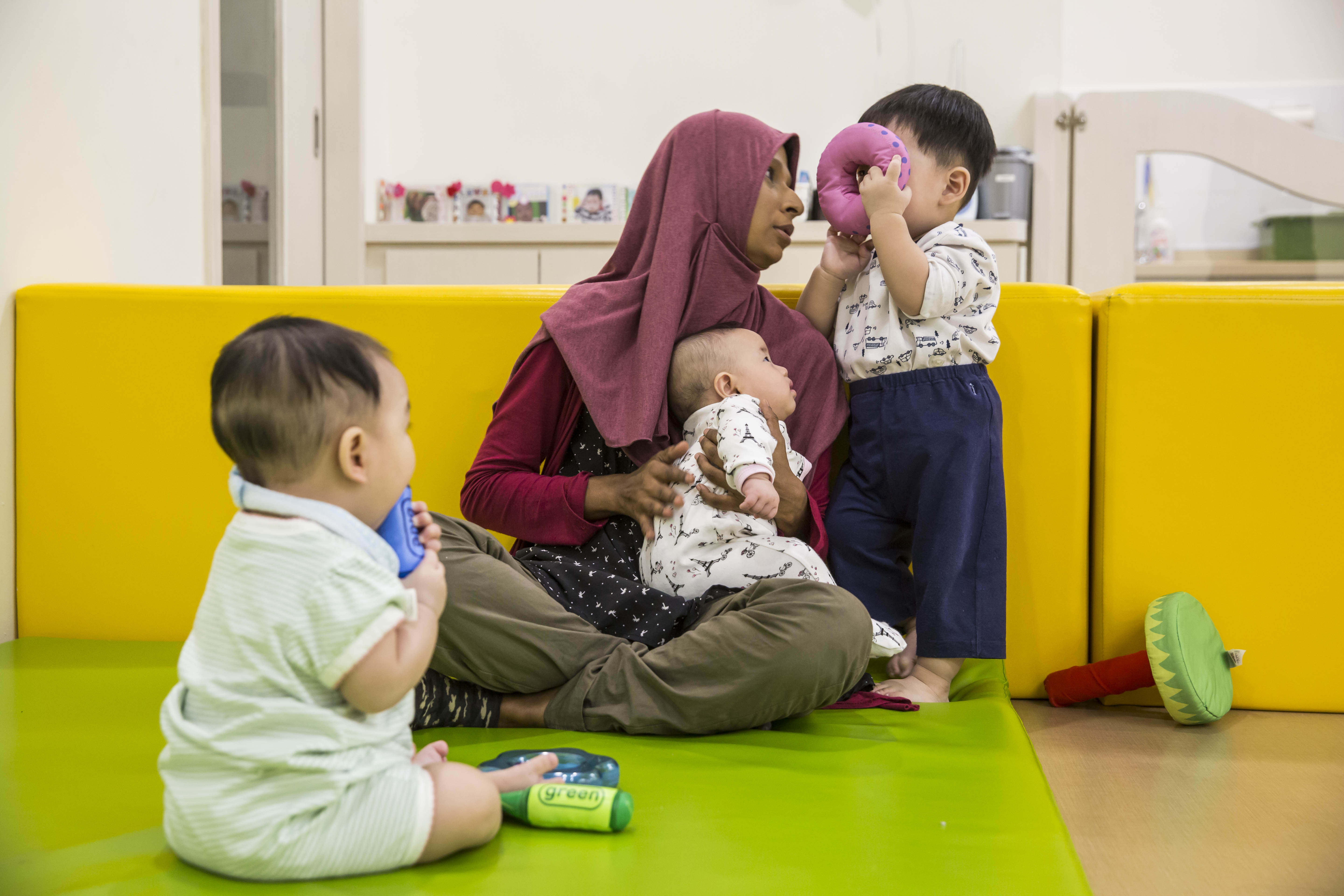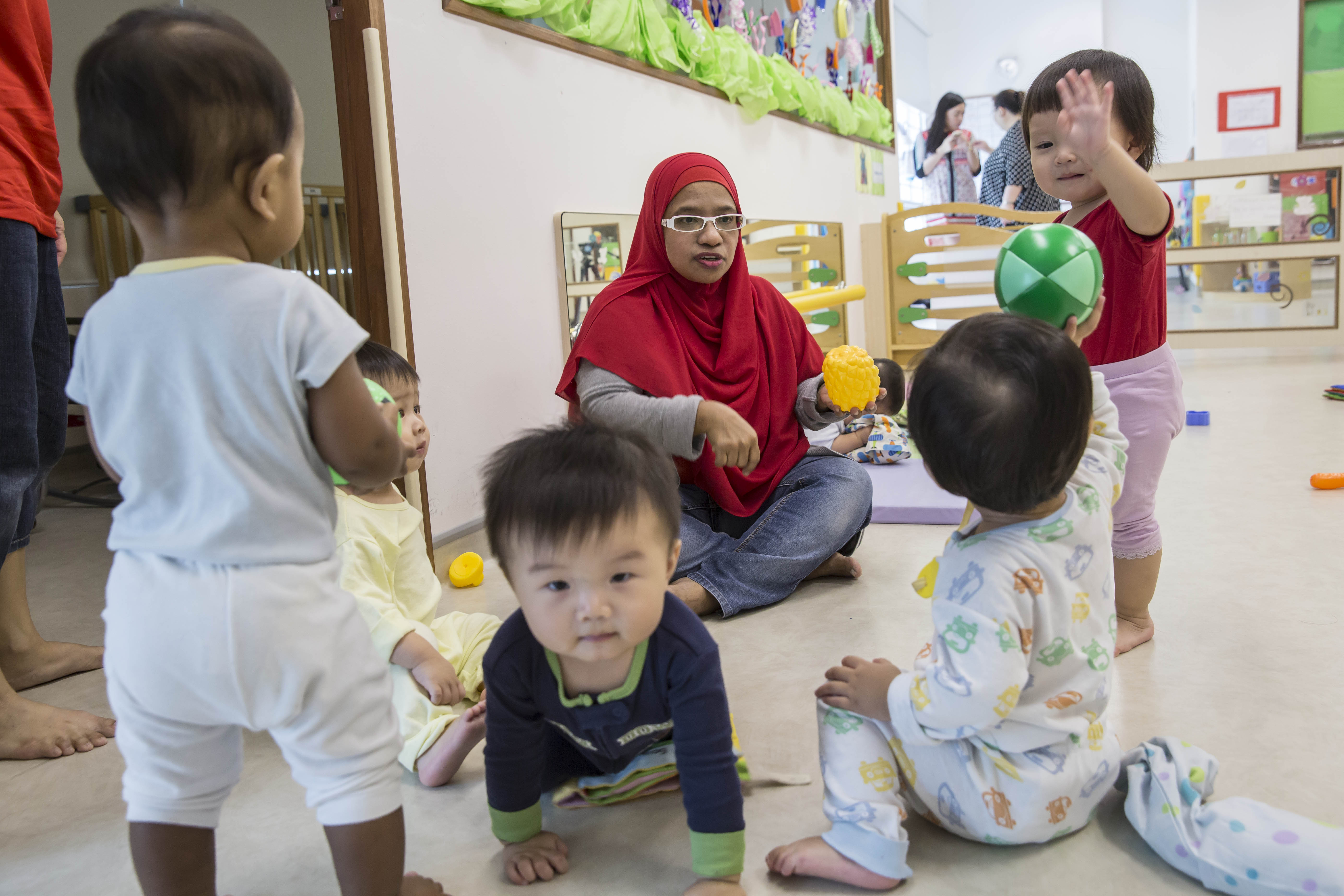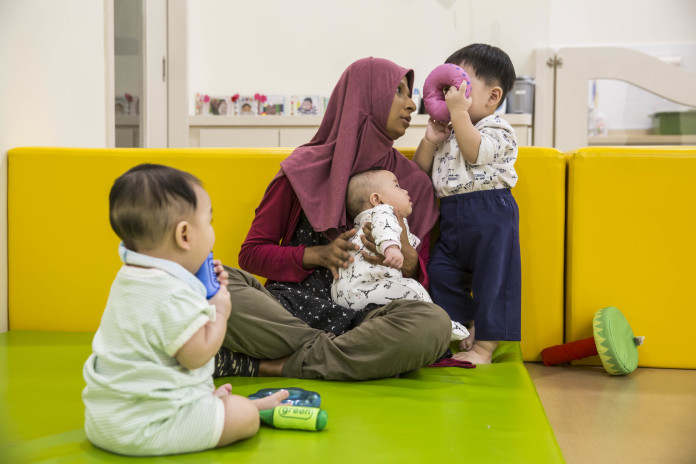SINGAPORE — Communications manager Sabrina Tay, 34, recalled her apprehension and how she was saddled with guilt about three years ago when she opted to put her then 12-week-old firstborn in infant care.
“When the babies cry, you’re always afraid no one will bother about them. Or if they get sick … you’re a bad mum for sending them there … I had people asking me, ‘Wow, you can (bear to do so) … It makes you feel very bad, but you have no choice,” she said.
Mrs Tay said she did not want to burden her mother-in-law — who was at the time carrying out major renovations at home — with looking after her daughter. When her second child arrived earlier this year, she initially hired a domestic helper – only to ultimately resort to putting her second child in infant care as well, after she had issues with the maid.
Similarly, Mrs Kimberlyn Tan, 30, had problems with hired help. “I’d rather send him to school where I can have peace of mind, rather than worrying while I’m at work,” said the key account executive, who tried in vain to juggle work and looking after her baby. Her husband is frequently away on business trips while her Malaysian mother-in-law regularly shuttles between Singapore and Johor Bahru.
Slowly but surely, stigma and a sense of guilt that afflict parents, especially mothers, for leaving newborns in the hands of someone outside the family and away from one’s home are gradually eroding. From as young as two months old, more and more infants are being placed in the care of professionals by working parents — some by choice, while others had few options — after futile searches for suitable and affordable nannies or bad experiences with domestic helpers, for example.
Parents who are tapping on infant-care services also tell TODAY that their own parents are either busy working or they wish to spend more time on themselves in their golden years, instead of looking after their grandchildren. Human resources professional Adeline Ng, 28, for example, has three young kids – aged 5 years and under – and her parents are in their early 50s. “When I was pregnant with my first child, I was already looking for infant care. My parents are young grandparents, so I wasn’t expecting them to give up their jobs to look after a baby,” she said. “To me, my parents have brought me up, and are finally getting a breather… I don’t want to have to burden them with a baby as we know that looking after a baby is not an easy task.”
A GROWING INDUSTRY

At My First Skool located at Punggol Waterway Point, a typical day involves the infants being fed milk or solid foods, getting their diapers changed, and getting some naptime. Depending on their ages, the infants may also participate in activities such as reading, sing-along sessions, and scrawling on A3-sized paper with chalk. Photo: Nuria Ling/TODAY
Earlier this month, Senior Minister of State (Prime Minister’s Office) Josephine Teo noted the sharp increase in demand for infant-care services in recent years. Mrs Teo, who helps to oversee the National Population and Talent Division, said about one in 10 babies who are 18 months old or younger are enrolled in centre-based care today, a growth of 60 per cent since 2012.
Early Childhood Development Agency (ECDA) figures showed that in 2012, there were fewer than 300 childcare centres – out of a total of 1,016 centres – which offered infant care services. As of the third quarter of this year, the number has jumped to 468 out of a total of 1,329 centres. In all, 4,221 toddlers are currently enrolled in infant care, compared to 2,604 in 2012.
The demand is so great these days that some couples start enquiring about the services when they are not even expecting a child yet, said Ms Bernice Sim, principal of Skool4Kidz Tampines GreenLeaf.
Experts and industry players attribute the increased demand to a combination of factors, including higher participation of women and seniors in the workforce, as well as parents’ greater acceptance and trust in the care provided by childcare centres. NTUC First Campus CEO Chan Tee Seng pointed out that the quality of infant care services has also improved, apart from the fact that these services are now widely available in convenient locations.
Adding that demand from younger couples especially has increased, he also noted the “considerable” government support to offset families’ expenses for childcare services. “We’ve seen a significant shift in parents’ need for both infant and child care over the past five to seven years, and their attitude towards it. Parents are quite happy and comfortable to leave their children at infant care centres these days,” he said. “People are more confident of sending their children to infant care, compared to leaving then with the foreign domestic helpers or grandparents.”
Like many couples here, personal assistant Christina Lueftenegger, 41, and her husband, who works as an executive chef, clock long hours at their workplace. After she gave birth to her son two years ago, she returned to work soon after and placed her child in infant care. Her mother has high blood pressure and it was not an option to seek her help.
“We needed the money of course, and I felt that I would want to continue to work… In the past, my mum would be a stay at home housewife, but now it has changed. Immediately after we graduate, we will want to look for a job and it continues… For me to switch to being a (stay-at-home mum), I didn’t (consider) because I felt I was young enough and I still would want to keep on working,” said the Singaporean, whose husband is Austrian.
The observers noted that the changing attitudes towards the outsourcing of care is part of a larger shift in Asia, which is following in the footsteps of Europe, especially the Scandinavian countries. Sweden, for example, provides services including round-the-clock childcare.
In Singapore, the industry has grown significantly, with a wide range of operators running a suite of half-day, full-day or flexi-care programmes.
At My First Skool located at Punggol Waterway Point, a typical day involves the infants being fed milk or solid foods, getting their diapers changed, and getting some naptime. Depending on their ages, the infants may also participate in activities such as reading, sing-along sessions, and scrawling on A3-sized paper with chalk. The timings of diaper changes, feeding and naps for every single one of the 11 infants currrently under the centre’s care are also recorded down. The centre’s executive principal Sylvia Yeo said: “We don’t have a fixed routine for the child as infants have their own (behavioural) patterns… so we follow their own routines.”
The older ones are brought to the nearby supermarket where they are taught new words. To keep the parents updated on what their child is doing at the centre, teachers upload photographs on an e-portal. Mrs Ng, who sends her kid to My First Skool at Bukit Panjang, is pleased with the effort and thinking the centre puts behind the design of its programes. “It’s not just toys which they buy off the shelf, it’s about doing things for the infants which are more sensory related… I don’t think that if I hired a helper, she would bother to do that.” she said.
The average full-day fees for infant care is currently S$1,478 a month, according to ECDA. The fees vary across different operators, depending on the programme which parents opt for as well as the subsidies they are eligible for.
In comparison, it costs about S$800 to S$1,500 to have an infant cared for at a babysitter’s home, and between S$2,000 and S$3,000 if the nanny is required to look after a kid at the employer’s place, said Mr Adrian Ng, director of nanny agency BBNanny.
Private preschool Kiddiwinkie Schoolhouse – which is run by Nurture Education Group – charges about $2,200 each month for its full-day infant care programme. It has a low staff-child ratio of 1:3 – compared to ECDA’s minimum requirement of 1:5 – and it provides services such as a baby spa. The centre also employs a full-time nurse. “(We also look into) the nutritional value (of the food), even the choice of music in the background, the lighting controls, the choice of toys selected… we pay special attention to all of these,” said Nurture Education Group co-CEO Matthias Koh.
EtonHouse International’s E-Bridge Pre-School offers full-day infant care at S$1,275 a month for Singaporeans. This year alone, E-Bridge opened four new centres providing infant care, including a new mega childcare centre in Punggol which can take in 30 infants. EtonHouse is part of the government’s pre-school Anchor Operator Scheme. Operators under the scheme receive government funding and get priority when sites at Housing and Development Boards are allocated.
Mrs Ng Gim Choo, founder and managing director of EtonHouse Group, said that E-Bridge, which has a “dedicated in-house curriculum team”, offers an “inquiry based programme” which integrates different developmental areas such as literacy, numeracy, science, and creative arts.
While parents gradually warming to the idea of placing their newborns at childcare centres, the educarers – or those who care for young children – said they have to gain the trust of parents, who would usually raise a whole host of questions and concerns before enrolling their infants. Madam Foo Mee Eng, 53, an infant care teacher at My First Skool at Punggol Waterway Point, said that trust can be built through constant communication and reassurances. She said in Mandarin: ““At first, parents are not familiar with you… so they are very worried. They will ask, ‘how do you know when my child is hungry, or needs to sleep, or why is the child sleeping so little today… But over time, once they see that their child is fine, they will trust you.”
Madam Rozinah Ibrahim, 46, infant care teacher at Skool4Kidz Tampines Greenleaf, said she and her colleagues also need to handle parents’ expectations and demands. For example, some would request that their child be given solid food more times in a day. Others would take issue with the aircon temperature or ask for extra attention to be given their child. Nevertheless, it is not the parents who pose the biggest challenge – it is the little ones themselves. “I’m always worried when the children come in and refuse to eat because it’s a new environment,” she said. “For instance, a child who doesn’t (usually) take brown rice at home, or an infant who’s used to breastfeeding and takes some time to drink from a bottle and keeps crying… But no matter what, we try our best to (adapt) suit a child’s needs.”

Madam Rozinah Ibrahim taking care of children at Skool4Kidz Tampines Greenleaf. Photo: Nuria Ling/TODAY
In order to ensure quality care is given at such centres, Dr Kok Siat Yeow, deputy director of programmes at SEED Institute, stressed that society needs to see that an educarer’s job goes far beyond babysitting duties such as bathing and feeding the toddlers. “People may think it’s easy, but they underestimate that it’s a very demanding job… You have to be very watchful, and plan, observe (the infants’) growth, assess their development and be accountable to parents,” she said.
To keep up with the sector’s demand, the SEED Institute has trained more than 420 infant educarers since its inception in May 2013. This year, the institute saw six runs of the WSQ Advanced Certificate in Early Years programme, and it plans to increase the number to seven next year.
AN INEVITABLE TREND?
The number of infant care places has increased by about 47 per cent, compared to 2012. In all, there are 6,921 places as of the third quarter of this year. Actual enrolment stands at 4,221.
Mrs Teo noted that if the government wants to provide better support to millennial families, infant care is an area to look into. Apart from higher subsidies for fees and a certification framework for quality assurance, parents interviewed suggested a centralised enrollment system that could help shorten the waiting lists for popular centres. More centres, particularly in the non-mature estates, should also be built, they said.
Risk manager Kenneth Boey, 32, who lives in Sengkang, pointed out that there are no infant care services in the vicinity. Business advisor Alex Tay, who is in his late 40s, recalled that it took a while before he managed to secure a place for his son at My First Skool at Marine Terrace. “You have to do pre-booking at a few places, so one set of parents can be putting their names on three or four centres… as a result, it artificially extends the long queue… Going ahead, a centralised system might be better,” he said.
Sociologists said they expect the demand to continue to grow.
National University of Singapore (NUS) sociologist Tan Ern Ser said: “We are moving towards using professional help in more areas of our lives, so why not infant care as well?” He noted that caregivers are “trained specialists and therefore perceived to be in a better position to provide quality care”. “The bottom-line is that if there is quality care, minus the tension and anxiety that may be associated with the more ‘traditional’ arrangements, then why not,” he said. Fellow NUS sociologist Vincent Chua felt that the trend “reflects social conditions” and is driven by a variety of factors including the lack of alternatives at home, a greater ability and willingness to pay for professional services, as well as an increasing number of options in the market. Grandparents who are working themselves may not be able to take care of the children, he added.
Clinical coordinator Rosie Yeo, 53, for example, told TODAY that she had considered retiring earlier to help look after her grandson. However, she felt she was not ready yet to give up a job where she has spent almost three decades in.
“I love looking after (my) patients… Seeing that they are feeling good gives a sense of reward and job satisfaction for me… As long as I can still meet the (company’s) expectations, I’ll still stay,” said Mdm Yeo, who aspires to open a cafe one day. Nevertheless, she helps take care of her grandson on weekends, when she is not busy pursuing her passions such as cooking for her church.
Mr Tay noted that some young couples may, in fact, prefer to send their children to infant care centres – to avoid conflicts with their parents. “(There may) be too big a generation gap in upbringing or teaching style, where the husband and wife have already come to some understanding on what are the dos and don’ts… You don’t want to involve another set of decision makers,” he said.
Still, there are some parents such as admin executive Noraini Hussin, 31, who are not keen on infant care services. Ms Noraini said if push comes to shove, she would choose to work part-time to care for her two-year-old daughter and three-week-old son. Currently, her mother is helping her with them. “Every child is different, and to have four to five children being taken care by one person, no matter how experienced or professionally trained you are, I still don’t have the confidence of having any of my kids under the care of a complete stranger,” she said.





